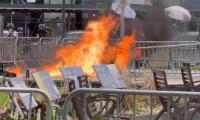ISLAMABAD: Punjab is ahead of all the provinces in Human Development Index according to the Pakistan National Human Index Report released by the United Nation Development Programme.
The thresholds used for this report categorise Pakistan as a country with medium level of development.
Punjab stands first securing 0.732 points followed by Sindh with 0.640 points, Khyber Pakhtunkhwa with 0.628 points and Balochistan with 0.421 points on the HDI table.
The immunization rate in Punjab is around 89 percent, around 78 percent in KP, 73 percent in Sindh and around 51 percent in Balochistan.
All over Pakistan, there are only six districts ranked as high-human development districts. Four of these districts are in Punjab and none from the KP.
The next category is high medium human-development districts. Four KP districts make it, but against 19 districts from Punjab.
Some 78.3 percent people in Punjab are satisfied with health facilities, 73.2 percent in Sindh, 72.7 percent in KP and 65.8 percent in Balochistan.
A normal person in Punjab spends at least 10.1 years in school while expected years of schooling in KP are 9.7 years, 8.3 years in Sindh and 7.4 years in Balochistan.
83 percent people in Punjab, 67.6 percent in Sindh and 67.1 percent in KP have a better living standard. In Balochistan, this figure is around 33.9 percent.
Punjab is ranked among High Medium Human Developed place while Sindh and KP fall among the Medium Human Developed places and Balochistan is Low Human Developed place.
In Youth Development Index, Punjab is number one with 0.57 points with Sindh at number two with 0.538 points. KP and Balochistan are at the bottom of the table with 0.394 and 0.373 points respectively. Eastern Punjab and Northern Punjab with respective scores of 0.611 and 0.607 are placed in the category of high youth development.
Central Punjab (0.563), Western Punjab (0.528) and Southeastern Punjab (0.518) are ranked as medium youth-development regions.
Southeastern Punjab is ranked medium youth-development region compared to low youth-development ranking of Southern K-P (0.423) and Central K-P (0.412). Northern K-P (0.380) is further down the line in the category of very low youth development. KP is not only behind Punjab, it also falls far behind even Southeastern Punjab.
In Punjab, 73.6 percent youth is literate while in Sindh this figure is around 67.7 percent and in KP it touches 63.5 percent. In Balochistan, 50 percent youth is literate.
In the category of multidimensional Poverty Index in provinces, Punjab is the least poor province with 0.152 points, Sindh with 0.231 points, KP with 0.25 and Balochistan with 0.394 points.
Regarding the health index, around 90 percent females and 89 percent males in Punjab are immunized. In KP, 79.5 percent females and 77 percent males, in Sindh 72 percent females and 74 percent males and in Balochistan 52 percent females and 50 percent males are immunized.
Unemployment rate in Balochistan is 3.9 percent, around 4.8 percent in Sindh, around 5.2 percent in Punjab and around 7.9 percent in KP.
Gender parity: There is significant disparity between literacy levels for females compared to males at all provincial levels. Punjab’s male literacy level (10 years and older) is 71 percent compared to the female literacy rate of 55 percent. In Sindh, it is 70 percent and 49 percent, KP 71 percent and 35 percent, Balochistan 61 percent and 25 percent.
The highest Technical and Vocational Educational and Training participation is among male youth from north Punjab (33.7 percent) followed by eastern Punjab (17.4 percent).
The highest participation in KP is in the central region (8.8 percent). In Sindh, the highest participation is in the eastern region (6 percent). Balochistan is at the bottom, its highest participation being in northern Balochistan (2.6 percent).
Saad was of the view that the battle of politics should be fought solely through political means
KP govt decided to develop gemstone business as a formal export sector and cluster at the Namak Mandi would be...
Khyber Pakhtunkhwa Minister for Higher Education, Archives, and Libraries, Meena Khan Afridi. — APP FilePESHAWAR:...
Vehicles and horse carts passing through flood water at Bara Bazar area on Khuwani bridge after heavy rain in Peshawar...
Amid the failure to revive the cash-bleeding PIA, government is left with no other option but to sell it to any...
Picture showing the Silver Jubilee Gate of the University of Karachi. — APP File KARACHI: The University of Karachi...







